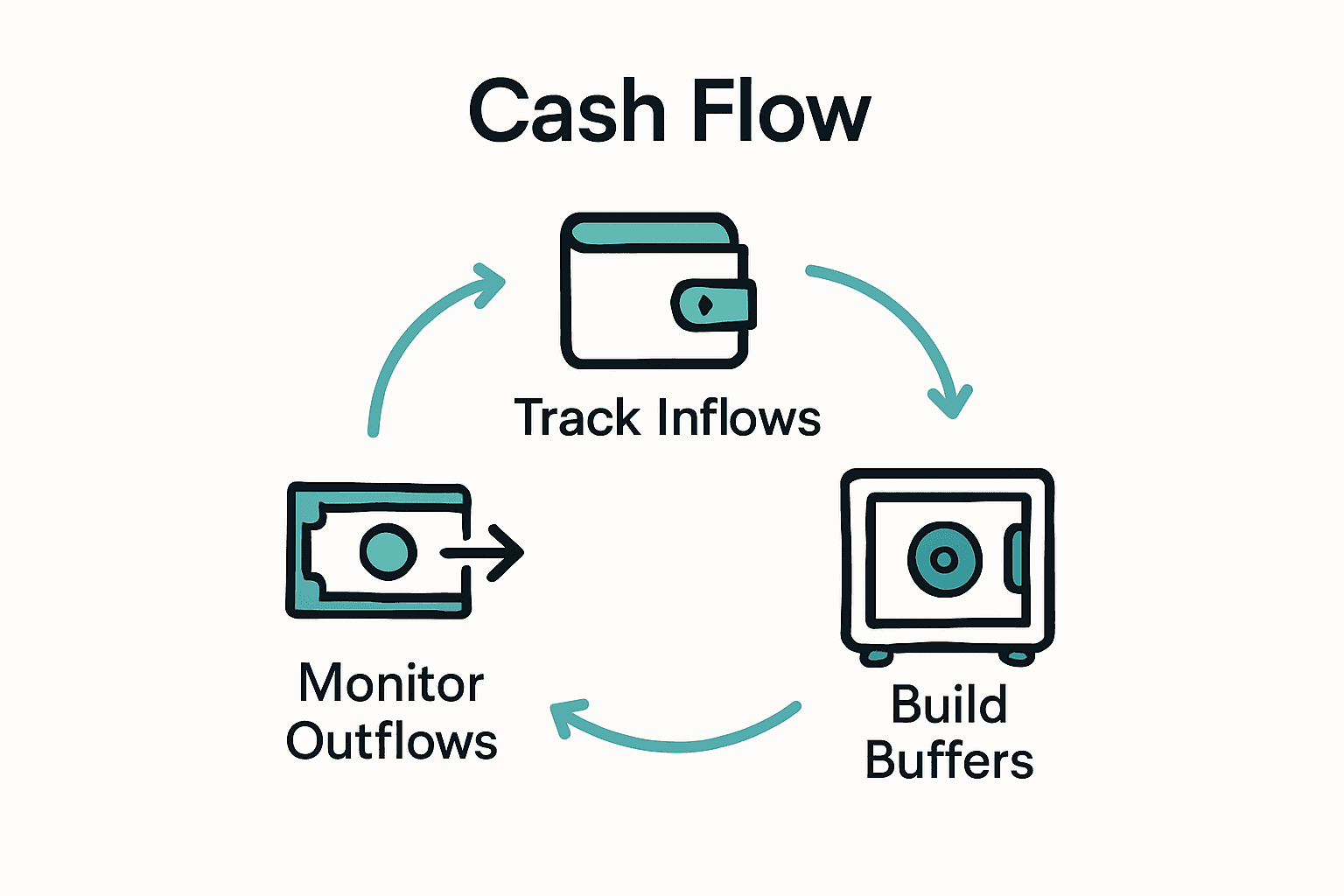Over 60 percent of american small businesses say cash flow issues have put them at risk of closing at some point. Whether you run a business or manage your household, understanding cash flow is central to financial stability. Knowing the key concepts behind cash flow management helps you spot problems early, build financial security, and make smarter choices with your money. This guide reveals how mastering cash flow can keep your financial future on solid ground.
Table of Contents
- What Is Cash Flow Management? Core Concepts
- Types of Cash Flow and Their Distinctions
- Key Metrics and Tools for Tracking Cash Flow
- Effective Strategies for Managing Cash Flow
- Common Pitfalls and How to Avoid Them
Key Takeaways
| Point | Details |
|---|---|
| Effective Cash Flow Management | Involves tracking incoming and outgoing funds to maintain financial health and optimize resource allocation. |
| Types of Cash Flow | Four primary cash flow categories—operating, investing, financing, and outflows—offer insights into an organization’s financial dynamics. |
| Key Metrics for Tracking | Important metrics like Operating Cash Flow Ratio and Cash Conversion Cycle help monitor cash flow and anticipate financial challenges. |
| Avoiding Common Pitfalls | Recognize and mitigate pitfalls such as overestimating income and insufficient emergency funds to ensure financial stability. |
What Is Cash Flow Management? Core Concepts
Cash flow management is the strategic process of tracking, analyzing, and optimizing the movement of money into and out of a business or personal financial ecosystem. According to research from bwjournal, effective cash flow management involves understanding and monitoring three critical financial streams: operating, financing, and investing cash flows.
At its core, cash flow management is about maintaining financial health and ensuring your money works efficiently. Incoming cash represents revenue from sales, investments, or other income sources, while outgoing cash includes expenses like operational costs, salaries, taxes, and investments. The goal is to create a positive cash flow where your incoming funds consistently exceed your outgoing expenses. As insights from hillpublisher highlight, this practice is fundamental to supporting sustainable business management and financial stability.
Key aspects of effective cash flow management include:
- Forecasting future income and expenses
- Tracking real-time financial movements
- Analyzing spending patterns
- Identifying potential cash shortfalls
- Creating strategic financial buffers
Professional cash flow management goes beyond simple bookkeeping. It requires continuous monitoring, proactive planning, and the ability to make swift financial adjustments. By understanding your financial streams and anticipating potential challenges, you can transform cash flow from a passive accounting function into a powerful strategic tool for financial success.
Types of Cash Flow and Their Distinctions
Understanding the different types of cash flow is crucial for comprehensive financial management. According to research from ijebmr, there are four primary categories of cash flow: operating, priority outflows, discretionary outflows, and financial flows. Each type plays a unique role in providing insights into an organization’s financial dynamics.
Operating cash flow represents the lifeblood of any financial system. It captures the money generated from core business activities, such as sales revenue, payments to suppliers, and employee wages. Investing cash flow, as highlighted by carijournals, focuses on funds used for long-term investments like purchasing equipment, selling assets, or making strategic business investments. This type of cash flow reveals how a business is positioning itself for future growth.
The third critical type is financing cash flow, which tracks money related to debt, equity, and capital structure. This includes:
- Issuing or repurchasing stock
- Taking out or repaying loans
- Paying dividends to shareholders
- Raising capital through external funding sources
Each cash flow type tells a different part of your financial story. Priority outflows represent mandatory expenses like taxes and critical operational costs, while discretionary outflows include optional spending such as marketing investments or employee bonuses. By understanding these distinctions, you can create a more nuanced and strategic approach to managing your financial resources, ensuring both immediate stability and long-term financial health.

Key Metrics and Tools for Tracking Cash Flow
Effective cash flow tracking requires a comprehensive approach that combines strategic metrics and powerful analytical tools. According to en.wikipedia, Liquidity at Risk (LaR) is a critical metric that estimates maximum net cash outflows over a specific timeframe, providing crucial insights for proactive financial planning and risk management.
Key financial metrics for monitoring cash flow include:
- Operating Cash Flow Ratio: Measures ability to cover short-term liabilities
- Cash Conversion Cycle: Tracks time needed to convert investments into cash
- Free Cash Flow: Indicates money available after covering operational expenses
- Cash Flow Coverage Ratio: Assesses capacity to pay debt obligations
Professional cash flow tracking leverages both traditional and advanced tools. Dedicated portfolio theory emphasizes constructing financial portfolios that generate predictable cash inflows, aligning perfectly with strategic cash management objectives. Modern tracking solutions range from sophisticated accounting software to integrated financial management platforms that provide real-time insights, automated reporting, and predictive analytics.
These tools and metrics transform cash flow from a passive accounting function into an active strategic resource. By systematically monitoring financial movements, businesses and individuals can anticipate challenges, optimize resource allocation, and make informed financial decisions that drive long-term stability and growth.
Learn more about budgeting techniques to complement your cash flow management strategy.
Effective Strategies for Managing Cash Flow
Cash flow management requires a strategic and proactive approach that goes beyond simple financial tracking. Cutting-edge research from arxiv highlights innovative techniques using deep reinforcement learning to adaptively control resource flows, demonstrating that modern cash flow management is increasingly sophisticated and dynamic.
Key strategies for effective cash flow management include:
- Precise Forecasting: Develop accurate financial projections
- Expense Optimization: Regularly review and minimize unnecessary spending
- Payment Timing: Strategically schedule incoming and outgoing payments
- Emergency Reserves: Maintain robust financial buffers
- Diverse Revenue Streams: Create multiple income sources
Advanced cash flow management models, such as those explored in arxiv, propose bi-objective approaches that simultaneously maximize final cash flow and minimize project duration. This means thinking beyond traditional accounting and treating cash flow as a dynamic, strategic resource. By implementing systematic tracking, predictive analysis, and adaptive strategies, businesses and individuals can transform financial uncertainty into a controlled, optimized process.
 Learn how to manage financial stress effectively to complement your cash flow management approach and build long-term financial resilience.
Learn how to manage financial stress effectively to complement your cash flow management approach and build long-term financial resilience.
Common Pitfalls and How to Avoid Them
Cash flow management is fraught with potential mistakes that can derail financial stability. According to research from ideas, financial reporting can be manipulated through flexible cash flow classifications, highlighting the critical need for transparency and accurate financial tracking.
Common cash flow pitfalls include:
- Overestimating Income: Projecting unrealistic revenue streams
- Ignoring Small Expenses: Overlooking minor recurring costs
- Poor Expense Timing: Misaligning payment schedules
- Insufficient Emergency Funds: Lacking financial cushions
- Single Revenue Dependency: Relying on one income source
Entrepreneurial finance emphasizes that navigating capital shortages and market volatility requires proactive financial management. Understanding these potential traps allows businesses and individuals to develop robust strategies that mitigate financial risks. Successful cash flow management demands constant vigilance, realistic projections, and the flexibility to adapt to changing economic conditions. Learn strategies for managing credit card debt to further strengthen your overall financial resilience and avoid common monetary pitfalls.
Master Your Cash Flow with Expert Guidance
Cash flow management challenges like unpredictable income, expense timing, and insufficient reserves can easily cause stress and threaten your financial stability. This guide revealed crucial concepts such as operating cash flow, liquidity at risk, and strategic forecasting that every professional investor or business owner needs to understand. If you want to move beyond just tracking numbers and start using proactive strategies to optimize your cash flow, it is essential to have reliable support and tailored advice.
Take charge of your financial future today by visiting finblog.com where you can discover expert insights and practical tools designed to help you master these cash flow challenges. Don’t wait for uncertainty to take a toll on your finances. Learn how to manage financial stress effectively and build solid emergency reserves as part of your comprehensive cash flow strategy. Start now to transform your cash flow from a source of worry to your greatest financial strength.
Frequently Asked Questions
What is cash flow management?
Cash flow management is the process of tracking, analyzing, and optimizing the flow of money into and out of a business or personal financial system to maintain financial health.
Why is cash flow management important for businesses?
Effective cash flow management ensures that a business can cover its operational costs, invest in growth opportunities, and maintain financial stability by preventing cash shortfalls.
What are the main types of cash flow?
The main types of cash flow include operating cash flow, investing cash flow, financing cash flow, priority outflows, and discretionary outflows, each providing different insights into financial dynamics.
How can I improve my cash flow management strategies?
You can improve cash flow management by creating accurate financial forecasts, optimizing expenses, strategically timing payments, maintaining emergency reserves, and diversifying revenue streams.










